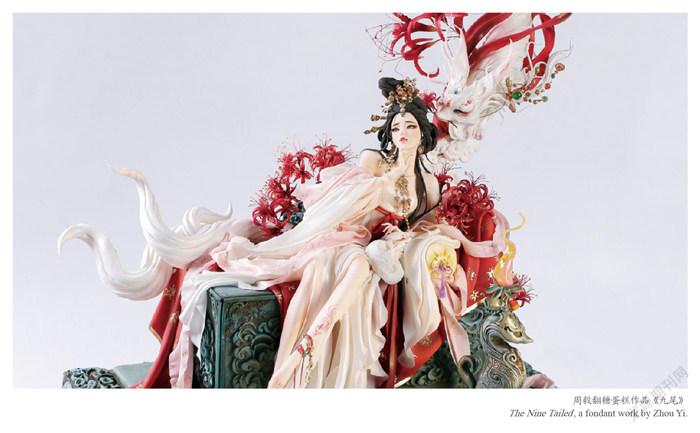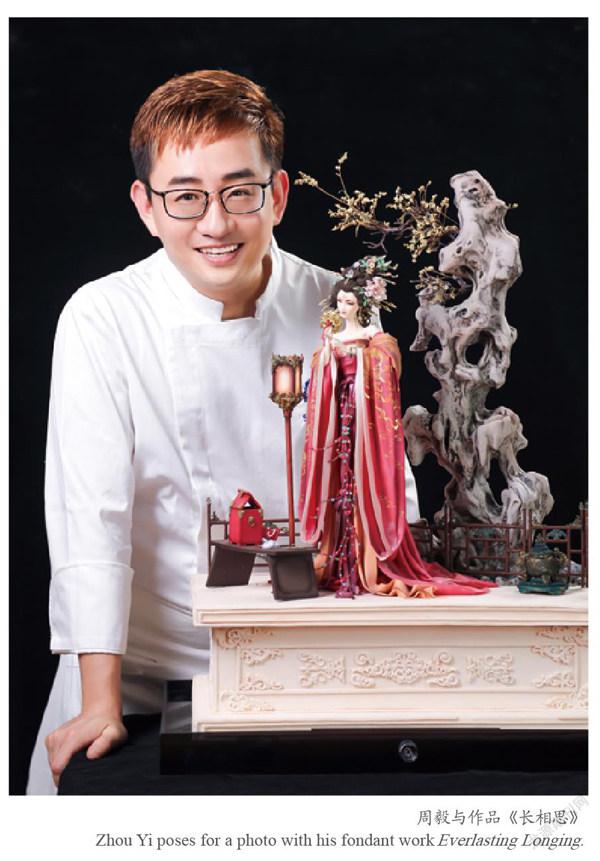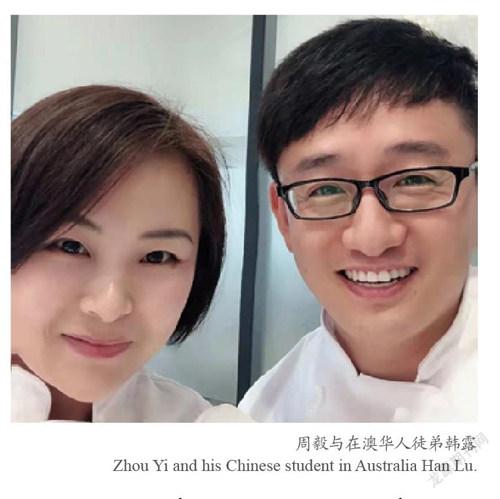中国糖王周毅: 温故知新,走向世界
2022-02-24吴洋
吴洋







《山海经 · 大荒东经》有云:“青丘之国,其山有狐,九尾。” 西晋著名文学家郭璞说九尾狐:“太平则出而为瑞。”在古代中国,见到九尾狐是子孙繁盛、国安邦宁的祥瑞征兆。据东汉赵晔《吴越春秋》记载,当年大禹治水来到绍兴涂山,见到涂山女儿九尾仙狐,根据涂山神谕,大禹便娶其为妻,成就了一番兴国安邦的大事业。然而,随着历朝历代的演义,九尾狐的传说也在不断演变,最著名的当是《封神演义》中的九尾狐控制了妲己,魅惑纣王,最后弄得殷商天下大乱,忠臣冤死,百姓生灵涂炭。
九尾狐,纯洁神圣而又妩媚妖娆,似仙似妖还似人。这一蕴藏复杂而丰富文化内涵的神话形象,被一位笑声爽朗、性格温和的“80后”青年用一个翻糖蛋糕(起源于英国的艺术蛋糕)作品唯美具象地展现了出来。
这位青年名叫周毅,他还有一个人们口中熟悉的称呼——中国糖王,曾斩获该领域多项国际大奖,《九尾》则是他目前最满意的翻糖蛋糕作品。
突破画虎画皮难画骨
温故知新是关键
“我想通过另一种方式再现中华传统文化之美,同时又被更多年轻人所喜欢。比如做九尾狐形象,首先在主色调的选择上,大家更喜欢美好寓意的事物,所以我用了白色去体现飘飘欲仙的圣洁神秘之感;同时作为狐,如果失去魅惑之韵,好像又没有了魂,于是就以粉色作配合,并在表情和眼神上進行微妙处理,去体现狐的妖媚和狡黠。形象塑造上,则更偏向于国潮风和国漫风。”周毅介绍说。虽然九尾狐形象并不止妲己一个,但很多人熟悉的封神榜故事与商朝有关,因此他为作品配制了“青铜”底座。
谈到选用彼岸花提升整体效果,周毅说:“关于彼岸花花语的传说在全世界有很多版本,其中比较普遍的说法是‘有花不见叶,叶生不见花,花叶两相错’,虽然有点悲伤,但其实与九尾狐这一神话形象多舛的命运有着深层次的契合感。”
通过《九尾》,不仅可以体会这位青年创作者对每一个细节近乎苛刻的考量,还能感受到他对古典书籍、神话历史的热爱,更能参悟国潮、国漫崛起背后的一些市场逻辑。“用心去呈现和表达的东西,相信大家都能体会到,也都会喜欢。创作过程中,我会沉浸到要塑造的人物角色和心境中,去思考她的立场,揣摩她的神态以及一颦一笑间的肢体语言。”
老话常说,“画虎画皮难画骨”。如何画好骨?周毅提出要“温故而知新”,他认为,这也是在当下更好地继承和发扬中华优秀传统文化的关键所在。
从传统非遗技艺起步
因一个契机与翻糖蛋糕结缘
周毅出生于四川省一个普通家庭,父母待人敦厚而温和。在他童年记忆中,父亲下班回到家,总爱琢磨工艺美术方面的小玩意儿。或许就是这样的童年印象,在他的心里埋下了手艺创作的“小火种”。后来,周毅进入四川旅游学院(原四川烹饪高等专科学校)烹饪系,并师从四川省工艺美术大师、传统非遗技艺面塑传承人王龙,也是从那时起他发现自己在工艺美术上的天分。
彼时的他还在酒店上班,每天上完班回到宿舍已经是晚上9 点多了,接着练习食品雕刻技法一直到第二天凌晨4 点多,只睡两个小时左右又要赶去上班,这样的日子坚持了好久,他那时的最大心愿是“能好好睡一觉”。这样勤奋钻研的精神,更为其日后成为专业领域的大师奠定了重要基础,由于在雕刻、面塑人物形象上拥有极强的感染力,周毅收获了一大批粉丝。回忆起初入翻糖蛋糕行业的契机,周毅说:“有粉丝问我能不能帮他完成心愿,把面塑人物做成翻糖蛋糕,起初我对翻糖是完全陌生的,于是做了大量的国内外资料调查和研究,然后自己研制配方,最终完成了第一个作品。”
周毅说:“母校和老师的教授,赋予我在形象塑造技法上的基本功,培养了我对食品工艺美学的浓厚兴趣。翻糖制法尽管与之截然不同,但其实也是一门大学问,要求创作者必须了解人体结构、骨架构造、五官雕刻、服饰配饰、园林布景、建筑设计和国画绘画。”
国际顶级蛋糕大赛中屡创佳绩
全场被中国之美震撼
2017年年末,周毅凭借作品《武则天》和《醉卧忘忧境》等在英国国际蛋糕比赛(CAKE INTERNATIONAL)上获得了三金两铜的好成绩,其中一个还是全场最高奖。“一些外国嘉宾和评委不停地说,Amazing,amazing!这是中国人第一次在世界最大最权威的翻糖蛋糕比赛里拿到最高奖,当时的感觉就是为国争光了!”周毅至今仍对评选结果宣布那激动时刻记忆犹新。
在很多人包括周毅自己看来,那次比赛中《醉卧忘忧境》虽然获得了铜奖,但意义却超越了金奖。“佳人醉卧湖中石,壶中忧欢知不知”,作品赢得了众多评委的喜爱,有人甚至俯下身子以便更仔细地观赏其中细节。然而,因为制作湖水用的透明糖块太厚,无法切割,不符合参赛蛋糕可切割的要求,《醉卧忘忧境》差点遭遇被淘汰的命运,为了不让这件超乎想象、精美绝伦的作品明珠蒙尘,评委们搬着她斡旋于各个参赛组,几经波折破了例,终于为她争取到一个铜奖。
据周毅回忆,当时有一位英国评委,直接找到他说:“你的作品,让我看到了太多的中国元素,我非常喜欢中国文化。”细聊之后发现,这位评委老师还熟谙中国书法、工笔画、红木桌椅、青花瓷、香炉等,喜欢中国穿汉服的年轻人,这一切都让他无比向往。
就在一年后的2018年,周毅从全球十万名优秀蛋糕师中脱颖而出,摘得被誉为“蛋糕界的奥斯卡奖”——蛋糕大师组织 (CAKE MASTERS)评选的双料冠军——国际人偶蛋糕最高奖(MODELLING EXCELLENCE AWARD)和年度国际翻糖蛋糕设计全场最高艺术家奖(CAKE ARTIST OF THE YEAR),成为获此殊荣的中国第一人。周毅分享了晚宴中颁奖时的高光时刻:“当时现场有几千名来自全世界各个国家和地区蛋糕界的嘉宾、评委和业内大咖,全场的人都在给我们鼓掌,掌声持续了将近3分钟。还有一位行动不便的英国老爵士,甚至被人搀扶着从轮椅上站起来,从他站起来那一刻开始,几乎所有人都站起来鼓掌。”
學生遍布海内外
立志将中国国潮推向世界
周毅及其作品在国际上赢得较高知名度后,更是吸引了一些国际友人和旅居海外的华人专程漂洋过海前来拜师。杭州萧山人韩露就是其中的一位。硕士毕业后韩露曾就职于澳洲第二大建筑产品公司,出于对烘焙的热爱和对梦想的执着追求,她毅然辞去工作,师从周毅,开启了海外创业生涯,并成为意大利球王皮埃罗钦点蛋糕师、澳大利亚百大杰出华人,翻糖蛋糕作品甚至在悉尼歌剧院展出。
除了学生遍布海内外之外,通过翻糖蛋糕让更多人了解中国传统文化的努力还体现在他对国潮风和国漫风的钟爱上,周毅的很多创作灵感都来源于此,“在很多世界级博览会上,以前看到最多的是美漫和日漫的作品,真的非常希望中国国漫也能在国际上收获越来越多人的喜欢”。
什么是中国国潮风、国漫风?概括地说,就是中国传统文化的年轻化,即传统文化“老树开新花”;所谓年轻化又并不单指受年轻人喜爱,而是意味着更接地气。这个时代的审美正在发生变化,越来越趋于个性化需求,如何在传统和现代审美之间找到平衡,做出符合时代审美的创意作品,并将它推向世界,展现中国传统文化的创新之美,这是周毅和他的团队一直以来积极探索的方向。
“我们今年推出了第一款全球限量版手办《“Don’t cry”——美人鱼》,前几天已经售罄了。曾经有一位80岁的爷爷打电话给我说,好喜欢我的翻糖蛋糕。我所理解的文化传承和发扬最好的外在表现之一就是传统文化通过可视化的东西走进千家万户,甚至走入世界各国各地区的普通家庭中。”周毅说,未来团队还将进一步开拓海外市场。
通过承袭面塑、雕刻之技艺内核,深挖优秀传统文化之精髓,培养德艺双修人才、助力他们开辟事业新天地,并借用翻糖蛋糕这一起源于西方的食物作为文化载体扩大中华文化的国际影响力,周毅的努力收获了无数成功,也为传统非遗技艺的发展找到了一条独具匠心且更为时尚、新颖的路子。用他自己的话说,“温故知新”,是让中华传统文化传下去这一课题的应有之义。
China’s Sugar King Wows the World
By Wu Yang
“In the mountains of Kingdom of Qingqiu [Green Hill], there lived foxes with nine tails,” according to the “Classic of the Great Wilderness: The East” (“Dahuang Dongjing”), a chapter in the Classic of Mountains and Seas (Shanhai Jing), a classic Chinese text and a major source of Chinese mythology. Guo Pu (276-324), a famed literary figure during the Western Jin dynasty (265-317) and one of the foremost commentators on Shanhai Jing, said of the nine-tailed fox: “Its appearance in time of peace is an auspicious omen.” In ancient China, sightings of the nine-tailed fox were signs of fortune, prosperity and stability.
The Spring and Autumn Annals of Wu and Yue (Wuyue Chunqiu), an unofficial history on the battles between the states of Wu (ca. 12th century-473 BC) and Yue (2032-222 BC) during the Spring and Autumn period (770-476 BC), made references to the nine-tailed fox as well. In the book, the Eastern Han (25–220) author Zhao Ye wrote that when Yu the Great, one of Ancient China’s “Sage Kings”, went to Tushan (in present-day Shaoxing) during his time taming the great flood, met a nine-tailed fox fairy and, obeying the oracle, married her, which had contributed greatly to his success. However, the images of the nine-tailed fox had undergone dramatic changes over the years. The best-known one is perhaps Da Ji in The Investiture of the Gods (Fengshen Yanyi), a popular 16th-century Chinese novel. The body of Da Ji, originally a concubine of King Zhou of the Shang dynasty (ca 16th century-11th century BC), was said to have been taken control of by a nine-tailed fox spirit, who then bewitched the king and eventually led to his (and the dynasty’s) downfall.
It seems the nine-tailed fox can be both pure, holy and tempting, seductive, sometimes a fairy, sometimes an evil spirit, and sometimes humanlike. Now, such a mythical and complex creature, full of cultural significance, has been turned into exquisite fondant figurines — all artworks — in the hands of a Chinese pâtissier born in the 1980s.
Zhou Yi, one of China’s most talented cake decorators and a globally recognized master baker, is more popularly known as China’s Sugar King. For his elaborate works, Zhou has won multiple international awards. The Nine Tailed is among his many masterpieces, and it is by far Zhou’s favorite creation.
“What I was trying to do was to reproduce the beauty of traditional Chinese culture in another way, making it more appealing and more attractive to the young generation at the same time,” explained Zhou of his conception of The Nine Tailed. “When creating the image of the nine-tailed fox, for example, first of all, I chose while as the main color, which symbolizes sanctity and pureness, and is mostly applied on things with a more positive connotation.”
“On the other hand, without a tinge of seductiveness, the fox will seemingly lose the soul, so I have put the color of pink into the mix, and made a few subtle and delicate changes to the figure’s facial and eye expressions, to reflect the bewitching and cunning side of the fox,” Zhou added. In terms of the overall image, the figure has taken on a more guochao (literally “national tide”, which implies a Chinese-culture-focused fashion trend) and guoman (literally “national aminations”, or Chinese animations) styles. Thanks to the popularity of the tales in The Investiture of the Gods, Da Ji the concubine is often considered as the nine-tailed fox. Therefore, Zhou made a bronze (the hallmark of the Shang dynasty when Da Ji lived) pedestal for the figurine.
The Nine Tailed shows not only the young artist’s rigorous — sometimes to the point of exacting — standards for every detail, but also his love for China’s classics, mythology and history. Behind the public recognition for The Nine Tailed and Zhou’s other works also lies the reason why the guochao and guoman trends are rising in the market. “I believe everyone can appreciate and enjoy the creations, as they have been done and presented with all my heart,” said Zhou. “In the process of creation, I will immerse myself in the characters and their ‘minds’, to think about their positions, figure out their attitudes and body language.”
As an old Chinese saying goes, “It is difficult to get to the bones when painting a tiger.” To get to the kernel of the matter, according to Zhou, it is essential to “review the old so that one can learn the new”, which he believes is the key to better inherit and carry forward the best of traditional Chinese culture.
Zhou was born into an ordinary family in Sichuan province, and his parents are kind and gentle. His father is in fact already a dough sculptor, who seemed to be always trying new ideas to make his pastries both mouthwatering and eye-catching. Those pastries and childhood memories have probably got Zhou interested in making creative pastries. Later, Zhou enrolled in the Sichuan Tourism University (formerly Sichuan Higher Institute of Cuisine) and studied with Wang Long, a Master of Sichuan Arts and Crafts and an inheritor of making dough figurines, an intangible cultural heritage. It was at that time that he discovered his talent in bringing flower buns and dough sculptures to life.
He was still working at a restaurant then, and usually it was already past 9 pm when he returned to the dormitory after work. Zhou would continue to practice making fondant making for another seven hours and rushed to work, sleeping for only two hours in between. During those days, Zhou’s best wish was “to have a good sleep”. The hard work laid a solid foundation for his becoming a fondant cake master. Making some of the most vivid dough figures, Zhou won a large following. “One of my fans asked me if I could help him fulfill his wish to make the dough figurines into fondant cakes,” Zhou recalled. “At first, I was completely at a loss, knowing nothing about it. So I did a lot of investigation and research from Chinese and international sources materials, and then developed my own recipes, and finally completed my first work.”
“My teachers in my alma mater have taught me the fundamental skills and techniques, and cultivated my passion in the art and craft of cooking food,” Zhou said. “Fondant-making in itself is big subject to explore, which requires the creators to understand the structure of the human body and to learn facial sculpture, clothing and accessories, landscape settings, architectural design and even traditional Chinese painting.”
At the UK’s Cake International in 2017, the works of Zhou and his team won three gold and two bronze prizes. The cake Lady in the Palace, featuring Empress Wu Zetian, the only female ruler in China’s history, won the International Best in Show prize, and Zhou became the first Chinese to win the top prize in the world-renowned competition. “Some international guests and judges kept saying ‘amazing, amazing’, and I was winning honor for my country,” Zhou still remembers his excitement when the results were announced.
For many people, including Zhou himself, another entry Lie Drunk in Nepenthic Land, despite only winning the bronze, is even more significant. The cake was warmly received by the judges in the competition — a few even stooped low to observe and appreciate the details, but the crust of the cake was too thick to cut, which ran against the rules and almost got the entry eliminated. However, to get this unimaginable and exquisite artwork what it deserved, the judges did everything they could and eventually secured it a bronze prize.
“I see so many Chinese elements in your works and I’m very into Chinese culture,” a British judge went to Zhou and told him. It transpired that the judge was also a fan of Chinese calligraphy, fine brushwork painting, mahogany tables and chairs, blue and white pottery, incense burners, among others, which he yearned for.
Just a year later, in 2018, Zhou Yi won the Cake Masters Magazine Modelling Excellence Award and the Cake Masters Magazine Cake Artist of the Year, becoming the first Chinese to win the title. “Thousands of guests, judges and masters from all over the world in the cake industry were present,” Zhou said of the awarding ceremony. “All were applauding us, the award winners, and the applause lasted nearly three minutes. An old English gentleman was even helped to his feet from his wheelchair, and from the moment he stood up, everyone did the same and clapped.”
After Zhou Yi and his works won global recognition, international friends and overseas Chinese travel all the way to China to learn their trade under Zhou. Han Lu, a native from Hangzhou’s Xiaoshan district is one of them. After obtaining her master’s degree, Han worked at Australia’s second largest architectural products company. But her love for baking and her determination to pursue her dreams ultimately led her to quit the job and learn after Zhou Yi. Later, Han started her baking career overseas, and became the chosen pâtissier for Alessandro Del Piero, the Italian football legend. Her fondant cakes were on exhibition at the Sydney Opera House.
Zhou’s inspiration for his creation mostly comes from guochao and guoman, which are his favorites. “In many international fairs, the most popular works are often American comics and Japanese animations. I really hope that guoman, or Chinese animations, can gain more international recognition as well.”
What are the styles of guochao, the Chinese-culture-focused fashion trend, and guoman, Chinese animations? Simply put, they result from the “youthization” of traditional Chinese culture. On the other hand, “youthization” doesn’t just equal to being liked by young people; rather, it means being more down-to-earth and relevant. In the current era, aesthetic tastes are changing constantly and getting more personalized. Zhou Yi and his team have been actively exploring ways to find a balance between the traditional and the modern, make creative works in line with the times, and promote them to the world to show the innovative beauty of traditional Chinese culture.
“This year we have issued the first global limited edition of the ‘Don’t cry’ — Mermaid garage hit, which was sold out a few days ago,” Zhou introduced. “An 80-year-old grandpa once gave me a call, just to say that he loved my fondant cakes. To my understanding, one of the best outward indicators of successful cultural inheritance is its presence in every family via visualized shapes, forms or formats.” In the future, Zhou said he and the team will further explore the overseas markets.
